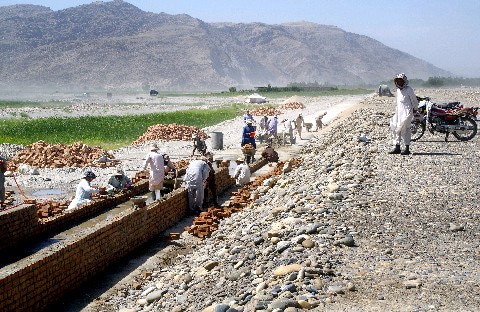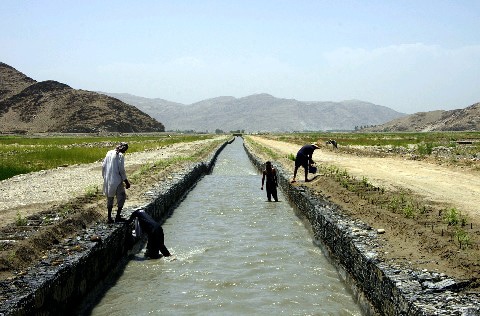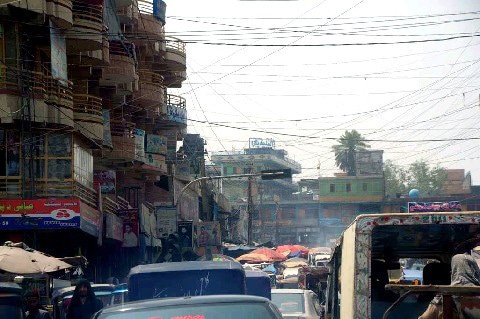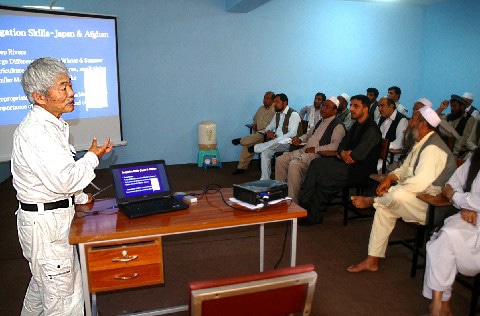【In the land of the Afghans – Reports from Dr. Tetsu Nakamura】Extreme weather and the price of peace
Published on September 3, 2018 - The Nishinippon Newspaper
Like Japan, Afghanistan is also extremely hot this year. In June, indoor temperatures in Jalalabad, the provincial capital of Nangarhar Province in eastern Afghanistan, exceeded 40 degrees Celsius over consecutive days, setting a record. High temperatures combined with limited rainfall have caused the entire eastern region of Afghanistan to become a burning inferno. For almost three months, there has been nothing resembling rain, the blue sky is hidden by dust clouds. Water levels in rivers have become so low that the desertification of agricultural land has sharply accelerated. Originally, Afghanistan’s farmlands were about 30% irrigated and 70% relied on rainwater. Non-irrigated fields have been devastated by the extremely low levels of rainfall that have continued for two years. Traditional underground waterways, known as Karez, have also been completely destroyed and land that could be used for farming has decreased sharply to 20% of the available total. Food prices are starting to skyrocket.
On the security front, there is concern that the ongoing conflict will be further escalated. An increase in US troops numbers has been reported, and widespread airstrikes have been ongoing since the beginning of the year. In addition, the movement of IS fighters from Syria into Afghanistan, along with US airstrikes, including mistaken ones, has further exacerbated the security situation.
■Deportations and returning refugees
It is estimated that more than two million Afghans suffering from daily food insecurity have fled to neighboring countries, as refugees, including Pakistan. However, Pakistan has also been facing a problem with the influx of refugees and has begun their systematic deportation since 2016 announcing a baseline figure of one million persons to be deported each year. Jalalabad has been flooded with returning refugees. With the Afghan government adopting a policy to keep refugees in the east, confusion has grown in the area.
With nowhere else to escape, displaced people are rushing from other parts of the region in search of water and livelihoods in Jalalabad, where the PMS project has turned 16,000 hectares of land into fertile farmland over the past 15 years. Jalalabad has become quite an exceptional area. The once quiet national highway from the north to inside the city of Jalalabad has become crowded over the past two years and an unbroken bazaar continues for tens of kilometers. The population density in the area seems to have reached its limit.
■In search of fertile land
PMS is planning to expand the area under stable irrigation using the current working site as a model. We are working together on ongoing activities with international organizations, however, these agencies underestimate the consequences of climate change, and aid contributions are generally on the decline. Yet, from our assessment, we believe that now is the most critical point for enhanced input.
As the rate of desertification has exceeded projections, irreversible changes can occur if left unchecked. With a 20-year-long project plan in mind, PMS established a training center this year to systematically train engineers from various regions in order to spread the concept of the PMS method of intake weir. Under the present desperate circumstances, we have been calling for the revival of agriculture, with the slogan "Food self-sufficiency, not war," to give people a glimpse of hope.
■Increasing global warming and desertification
Recent studies demonstrate that over the last 60 years temperatures in eastern Afghanistan have risen by 1.8 degrees Celsius, an alarming rate which is almost twice that of other regions.
In retrospect, the severe drought in Afghanistan was the first round in a “climate disaster” which is sweeping across the globe. We have heard of the submerging of islands due to sea-level rise, the global retreat of glaciers, and melting ice fields in the Arctic Ocean. On the land, the expansion of typhoons and hurricanes, frequent forest fires, and large scale floods and droughts have been reported here and there. However, as the responsibility for climate change is generally unclear, causes or measures of these issues are rarely substantively discussed. For example, in the discussion on the greenhouse effect, people’s fears have been neutralized by intentionally raising more counter-arguments. The economic predominance that ignores global warming remains firmly entrenched in our world. All these are built upon our unerring belief in science and technology that regards nature as an object which can be exploited infinitely.
In fact, the idea of overturning our modern way of life which has been linked to mass production and consumption ever since the Industrial Revolution is difficult for most people to accept.
■Food self-sufficiency, not war
We can no longer afford to procrastinate. The correlation between global warming, drought, and warfare is no longer an inference. The areas where security has deteriorated and the maps showing drought-affected areas, completely overlap. Without the guarantee of a daily meal, people drift into crime and employment as combatants, otherwise, their families would starve. These series of calamities even evoke images of the apocalypse. Overcoming drought is not a unique issue for Afghanistan, but rather one which the entire world needs to share and demonstrate solidarity to overcome.
× ×
This is a translation of a report from Afghanistan by Dr. Tetsu Nakamura, a Japanese medical doctor who was gunned down on December 4, 2019 in Afghanistan at the age of 73. Dr. Nakamura was the head of the international NGO, Peace Japan Medical Services (PMS). In addition to medical services, PMS provides various forms of assistance to local communities in Afghanistan’s eastern Nangarhar province, including the construction of irrigation systems, related agricultural programming and provision of food support. PMS is funded by Peshawar-kai, which was established in 1983 to collect donations from people and support the project implementation of Dr. Nakamura and his team.
This report is one of 27 installments in the series “In the Land of the Afghans – Reports from Dr. Tetsu Nakamura,” which ran from May 25, 2009 to December 2, 2019. They were originally published by the local newspaper in Dr. Nakamura’s hometown in Fukuoka, Japan. The text has been translated from Japanese to English, with the support of Peshawar-kai, by more than 30 volunteers, many of whom work in the field of humanitarian and development aid, and who have been and will continue to be inspired by Dr. Nakamura's work and philosophy.






